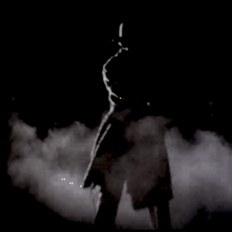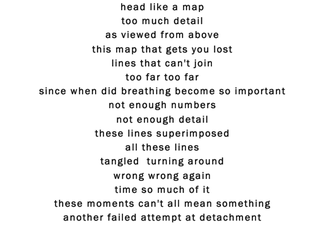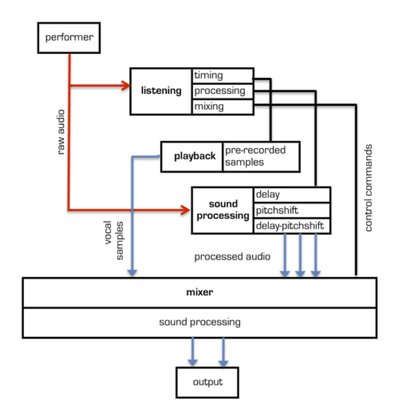2000
62 indeterminate heads [2000] improvisation score
61 noir [2000] MIBURI, Roland 505, t. sax, pno, samplers, MIDI controlled lights and MAX/MSP 20m

two fingers of scotch...
a long night face down in the alley...
blurred memories your own or someone else's from a
grainy fifties detective film
Noir takes up position within the grimy genre of Film-Noir. Its urban themes of identity, desire and obsession, make it a sibling work to my opera Rendez-vous. Noir's principal character, like that of Rendez-vous, is a low-life of ambiguous gender: perhaps a down and out detective who's taken one too many blows to the back of the head or maybe a femme fatale who's given too many. They are both inextricably linked to a client who they have never seen...at least not until now. In any case the tale in question - the invented fragments of a paranoid delusional or the faulty recollections of a failing consciousness, remains intentionally unclear
a long night face down in the alley...
blurred memories your own or someone else's from a
grainy fifties detective film
Noir takes up position within the grimy genre of Film-Noir. Its urban themes of identity, desire and obsession, make it a sibling work to my opera Rendez-vous. Noir's principal character, like that of Rendez-vous, is a low-life of ambiguous gender: perhaps a down and out detective who's taken one too many blows to the back of the head or maybe a femme fatale who's given too many. They are both inextricably linked to a client who they have never seen...at least not until now. In any case the tale in question - the invented fragments of a paranoid delusional or the faulty recollections of a failing consciousness, remains intentionally unclear
|
1. the stake-out 2. chase sequence with obstacles 3. a set-up 4. the alley-way [as viewed from above] 5. 22X [DoubleDoubleCross] |
Danielle Micich played the principal character, "perhaps a down and out detective who's taken one too many blows to the back of the head or maybe a femme fatale who's given too many." noir used a variety of relationships between the dancer, the sound and the lighting ranging from general large-scale atmospheric effects to cuter more dramatic effects such as allowing the dancer to trigger the sound of a match being struck in concert with a small spotlight illuminating her face. In the "chase sequence with obstacles" section Micich, seated in 'driving position' on a car bench was able to cue the horns, screeching tyres and flashing lights of virtual oncoming traffic.
Listen here. |
|
60 3 time pieces [2000] reciter, Roland 101, pno and bass and electronics
|
|
During 1999 I formed the multimedia group Disturbia with Micich, drum machinist Petro Vouris and Narrator Rachael Dease, to experiment with using the Miburi in a concert context. I was contacted by lighting designer Andrew Lake who had seen a performance and was keen to explore the possibilities of using the Miburi to manipulate MIDI controlled lights. We developed a performance around my text-based works three time pieces [2000] maintaining a very simple sound set up for the Miburi, but mapping the Miburi's sensors to a complex lighting rig.
These three works, time-fixt, as viewed from above and right now, are bound together by a concern for time, and most sepcifically the human time of memory. Although perhaps being complimentary, were conceived as independent works rather than a forming a related cycle. As with many of my text-driven works, there are connections between the structure and concept of the text and those of the the music: repeated words and phrases, meaning shifting through repetition and distortion over time. The sampled readings feature the fabulous voice of actor Martelle Hammer. Listen here. |
59 <as viewed from above> [2000] s. sax and interactive electronics MAX Software 9m
<as viewed from above> drew its inspiration from the Postmodern literary structure the ‘hypertext rhizome’ (Žižek, 2000 pp.37). In particular the notion of the hypertext rhizome as a dramatic paradigm developed by MIT professor Janet Murray. She coined the term ‘Violence Hub’ to designate hypertextural works in which a central event is examined from different perspectives.
|
The proliferation of interconnected files is an attempt to answer the perennial and ultimately unanswerable question of why this incident happened. These violence hub stories do not have a single solution like the adventure maze or a refusal of solution like post-modern stories; instead they combine a clear sense of story structure with a multiplicity of meaningful plots. The navigation of the labyrinth is like pacing the floor; a physical manifestation of trying to come to terms with the trauma; it represents the mind’s repeated efforts to keep returning to a shocking event in an effort to absorb it and finally, get past it. (Murray 1997 p. 135-6)
|
|
Žižek identifies the potency of this novel formal structure in Lacanian terms as referring to the “trauma of some impossible Real which forever resists its symbolization (all these narratives are ultimately just so many failures to cope with this trauma)” (Žižek 2000 p.38). <as viewed from above> attempts to sonically reproduce a formal structure of this type.
At the heart of <as viewed from above> is a short text. The software 'listens' to the live performance of an acoustic instrument, as a trigger for proceeding through the samples of a text. Each line of text is recorded as a separate sound file. The computer can choose to replay and manipulate any previously chosen sound file of text, but is constantly narrowing its own number of text choices. In effect the patch left to its own devices will choose to 'obsess' over - in this case repeating and deforming - an ever diminishing group of samples. The live performance 'distracts' this process and forces it to act upon new material until all of the samples have been exhausted. The text used in the work is shown in Figure 74.The MAX/MSP frequency analysis object fiddle~ forms the bridge between the live performer and the computer. This object is used to approximately map the current frequency and amplitude of sounds from the performer and also to estimated the beginnings of phrases based on amplitude changes. The performative model for the work is shown in to the right. |
|
|
The information gathered from the fiddle~ object is processed in three distinct layers. Layer one cues text samples based on the beginnings of the live performer's phrases. It also manages the samples so that the texts do not play simultaneously and have appropriate pauses between groups of lines of text. Layer two manipulates the samples that have been played up until that point. It uses frequency and amplitude information as well as information pertaining to the amount of activity in the live part to change playback speed, assign loops and loop lengths and pan the samples. The final layer creates an overall mix between the live performance, the expanding text and the manipulated text and processes the result using comb filters and reverbs.
The order of emergence of the lines of text is fixed. Its theoretical model, referencing a “psychological” paradigm of “obsession” in the moment and moving forward is an example of the investigation of a cognitive rather than explicitly musical type of formal structure. The formal structure of <as viewed from above>, in terms of total duration and the duration of interstitial spaces between the emergence of each new line of text is determined by interaction between the performer and the software. |



